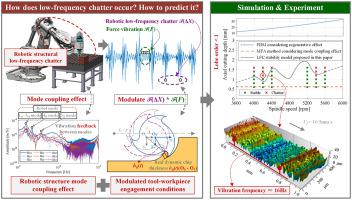International Journal of Machine Tools and Manufacture ( IF 14.0 ) Pub Date : 2023-06-15 , DOI: 10.1016/j.ijmachtools.2023.104048 Shihao Xin , Xiaowei Tang , Jiawei Wu , Fangyu Peng , Rong Yan , Wei Yang

|
In robotic milling with large allowance process, low-frequency chatter (LFC) is an important factor observed in high-speed and low-speed milling, affecting the processing efficiency and quality. Previous research has used the regenerative chatter theory, ignoring modulated tool-workpiece engagement conditions, or mode coupling theory under the assumption of threading operations to explain the LFC mechanism and predict the stability boundary. However, these models overlook or inaccurately characterize the modulation effect, leading to inaccurate modeling of dynamic chip thickness changes during milling, making it difficult to understand the mechanism of LFC. Here, we propose an LFC stability model that considers modulated tool-workpiece engagement conditions and the mode coupling effect of the robotic structure for robotic milling. This approach allows us to reveal the mechanism of LFC and identify the characteristic signal of low-frequency vibration, which is the sideband frequency signal. Initially, the evolution of LFC is analyzed, and its characteristics are summarized. Further, a surface renewal (SR) model is proposed to accurately calculate the dynamic cutting force caused by modulated tool-workpiece engagement conditions in LFC. Furthermore, the LFC stability model, considering the modulated tool-workpiece engagement conditions and mode coupling effect, is established based on impulse response function (IRF) method. Finally, we verify the accuracy of our model through milling experiments and compare it with that of the classical stability prediction model. Our results show that LFC is highly dependent on speed, and our stability model can effectively predict the stability boundary of LFC in robotic milling with large allowance process.
中文翻译:

机器人铣削中低频颤振的研究
在机器人大余量铣削加工中,低频颤振(LFC)是高速和低速铣削中观察到的重要因素,影响加工效率和质量。先前的研究使用再生颤振理论,忽略调制的刀具-工件啮合条件,或在螺纹加工假设下的模式耦合理论来解释LFC机制并预测稳定边界。然而,这些模型忽视或不准确地表征了调制效应,导致铣削过程中动态切屑厚度变化的建模不准确,从而难以理解 LFC 的机理。在这里,我们提出了一种 LFC 稳定性模型,该模型考虑了调制的工具-工件接合条件和机器人铣削机器人结构的模式耦合效应。这种方法使我们能够揭示LFC的机制并识别低频振动的特征信号,即边带频率信号。首先分析了LFC的演变过程,总结了LFC的特点。此外,还提出了表面更新(SR)模型,以准确计算 LFC 中调制的刀具-工件啮合条件引起的动态切削力。此外,基于脉冲响应函数(IRF)方法建立了考虑调制刀具-工件啮合条件和模式耦合效应的LFC稳定性模型。最后,我们通过铣削实验验证了模型的准确性,并将其与经典稳定性预测模型进行了比较。我们的结果表明 LFC 高度依赖于速度,



























 京公网安备 11010802027423号
京公网安备 11010802027423号